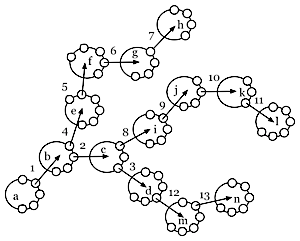Making a cup of coffee . . . or anything!

The dawn of attentive thinking
How do you make a cup of coffee? Or anything? It's fairly easy, now. We do it — and lots of other things — all the time. But long ago we hadn't learned to do anything — yet.
Here's an example of what I'm talking about. This is how I made the cup of joe that fuels this morning's blog post.

Starbucks Sumatra beans
Decide what kind of coffee to make. How about Starbucks Sumatra?

Measure of ground coffee
Grind the appropriate kind of coffee beans. Put a measure ( the blue plastic one in the picture) of beans into a Handground grinder. Grind the beans to a medium #5 grind. Place the grounds into the plunger hopper of an American Press coffee maker.
Twist the plunger assembly firmly in place atop the hopper holding the grounds. (You don't want it to come off at the bottom of the maker carafe sleeve!)

Press plunger assembly
Measure the amount of water needed using the marks visible on the carafe sleeve.

Press and kettle
Pour the carafe-measure of water into a Secura electric kettle. Press the switch to turn on the kettle. Watch for the switch light to turn off, which means that the water is vigorously boiling.

Preheat coffee
While the kettle heats, fill your cup with hot tap water to remove the morning chill. (I hate tepid coffee!)

Steep grounds for one minute
When the water is boiling, pour it into the American Press carafe.
Insert the hopper/plunger assembly into the upper part of the carafe. Push slowly down until the grounds are fully covered. The hot water will quickly darken to coffee color.
Let the coffee grounds steep for a minute, or longer, if you like a stronger brew.

Time for certainty
Slowly press the plunger through the hot water toward the bottom of the carafe. The pressure need is firm, about the weight of your arm, plus a little more.

Pour the coffee into your warmed (but now empty!) cup.

Fill preheated cup
I like to disassemble and clean my maker immediately so I don't have to do it later.

Clean up

All done!

Now to work
While you enjoy your coffee, think about this. That process is an example of how everything gets made.
Both the Handground coffee grinder and the American Press coffee maker are products of crowd-funded projects. Both underwent many steps. Many steps, involving very specialized equipment operated by skilled personnel make all the implements that support making this cup of coffee. And each item of specialized equipment also was developed and made through some combination, perhaps very complex, of basic parts combined in sequences of simple steps.

A simple process step
In the diagram, A simple process step, each large circle represents a specific moment. The smaller circles on the edges merely suggest alternative choices of "what to do now". The arrow represents the process of doing the chosen option. Moment a becomes moment b.
For even complicated machines and organizations, basic parts put together by simple acts. They are the source of everything we make! It's "merely" the combinations of parts and acts that are complex. But almost anyone can learn to do anything. You just have to pay attention and learn — or invent! — "the specific way and order by which set of parts are put together".

Simple sequence of steps
Simple steps are combined in sequences: one step follows another in a specific chain of moments.
That linearly focused way of paying attention to combinations of simple acts I call M1. It is the most basic of the active orders of attentiveness, i.e., the orders of "doing". It is called "linear" because we often think of such sequences in terms straight lines. The straight lines often have arrow heads to show the direction of process flow.

Forked sequences lead to complicated things

By the way, I have read that the Swiss artist, Paul Klee, invented the graphic arrow as a pointer during the 1920's or '30's. Before then, pointing fingers often were used to indicate direction on signs, etc. I don't know if Klee should get the credit, but he's one of my favorite artists, so I like to think that he's responsible for the important step in symbolics. After all, Oliver Wendell Holmes says that "The art of civilization is the art of drawing lines." Thanks, Paul! Thanks, for the shout out to artists, Oliver!
Graphically, lines have been used since very ancient times to represent relations between things. To show the way to a target. Or to find a treasure on a map. Or just to get somewhere.
Locations of things connected by lines are the very basis of road maps. Google and Apple maps merely present digital versions of what were first drawn in the dirt millions of years ago by our forebears trying to tell someone how to find some distant place. And by connecting sequences together you can create some very complicated systems of roads, or machines, or corporate institutions.

LA MetroLink map
M1 linear thinking is first encountered in childhood. For the earliest humans it blossomed into many C1 nomadic ways of life. "Great Journeys" were the reality for the earliest cultures over millions of years. And still, from time to time, today you hear someone refer to the "path of life", meaning a linear sequence of moments enjoyed, or suffered, "along life's way".

Job fair line
M1 linear thinking also is how individual children learn to pull up their "big girl or boy" pants during potty-training. It also is how they learn to tie shoes to go to church or school. It's how anyone learns to do anything — even to apply for unemployment you usually stand in line and then fill out forms. There are always steps and sequences of steps. If you don't master those, you don't do anything.
So why am I beating this theme nearly to death?
We now move into C5 organic understanding of our experiences. Such a "Great Re-Thinking" is forced by every great change in technology, especially in communications. C5 is brought on by the advent of computing. Through it we shall move toward the tech Singularity at C6. It behooves us now to really reassess how we take in every moment, everything!

Robot beast of burden
If we don't. If we merely continue as usual, we very likely shall fail in transition as so many great cultures — China, Egypt, Greece, Rome, the list goes on — have failed in the past. Why? Because our thinking is grounded so firmly in older, often obsolete patterns that we can't even agree on how best to use technology to our mutual benefit.
Our bodies were built in C0 and C1, over two distinct periods of millions of years, from the time when we were just another species of animal. About a million and a half years ago we began building our minds as 'thinking events'.

Early tools
In that period we awakened to the fact of change. Individuals learned to sustain attentiveness to sequences of steps in process or development. Those patterns formed the first linear cultures at C1. There, we learned to scheme and do basic things. There we came to realize that each moment changes into a next moment. That we can make something happen because we want it to — if we just exert the effort to make it happen.
During the agrarian revolution that began 5..10K years ago, at the very first beginnings of C2, we discovered how to feed large populations. To do that we began to claim lands that former C1 peoples had thought to be open, free and available to all living creatures. Of course, to claim and hold territory means you must fight off rival claims. So we also built armies; many became professional warriors.
Earlier posts present the C# notation and cultural themes that run through this current sequence of blog posts:
And if you're interested in how I first came to these ideas, take a look at my first post here, Why Steemit is the greatest leap in 1,000 years.
My companion site, Manifest Orders: Dimensions of Attentiveness discusses these and related matters in greater details.
Next post, we'll take a look at The First Great Awakening into M1 among attentive individuals. They created the earliest social cultures of humankind, the The C1 Nomads.
Congratulations @johojo! You have completed some achievement on Steemit and have been rewarded with new badge(s) :
Click on any badge to view your own Board of Honnor on SteemitBoard.
For more information about SteemitBoard, click here
If you no longer want to receive notifications, reply to this comment with the word
STOPBy upvoting this notification, you can help all Steemit users. Learn how here!
I just use my keurig. :-)